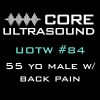87 year old male with a history of hypertension called EMS after having leg numbness earlier in the day, then a sudden onset of a headache with radiation to the back of his neck. The pain resolved right before EMS arrived at his residence. After unloading in the ambulance bay, the patient began to exhibit AMS, then lost pulses.

This bedside echo demonstrates an intimal flap in the ascending aorta, just past the aortic valve – as well as significant aortic regurgitation. When return of spontaneous circulation (ROSC) was achieved,further views were obtained and the following clips demonstrate dissection in both the descending and ascending aorta (PLAX and suprasternal views).
Soon after achieving these views, the patient lost pulses and CPR was restarted. While CPR was being performed, the following view was obtained of the carotid artery showing dissection:
During the next pulse check a subxiphoid view of the heart revealed an accumulating pericardial effusion, not initially present:
Aortic dissection (AD) is a vascular emergency that carries significant mortality. It has been reported to have a 1-2% increase in mortality per hour for 24-48 hours1 and a 2 week mortality of 80% if left untreated.2 The tear typically begins at the level of the right lateral wall of the ascending aorta or at the ligamentum arteriosum on the descending aorta. It can extend in a superior or inferior direction. Stabbing chest or back pain is the most common presentation, but 8-15% of patients can present with no chest pain. Other presenting complaints include abdominal or flank pain, cerebral or spinal neurologic deficits, myocardial ischemia, dysphagia, hoarseness or hematuria.1 While the most specific sign reported are pulse deficits, they are only seen in 38% of patients with aortic dissection.3 Chest X-ray (CXR) is a poor test with only 10-18% of CXR showing the characteristic widened mediastrinum.1 Gold standard imaging includes CTA, MRI, or transesphogeal echocardiography (TEE) with reported sensitivities ranging from 98-100%.4 These imaging modalities, with the exception of a TEE cannot be performed at the bedside, and TEE is not available at the bedside in most institutions.
Transthoracic echocardiography (TTE) is a useful bedside tool that can assist in the rapid diagnosis and disposition in a patient with suspected AD. It has been reported to have a sensitivity of 59-83% and a specificity of 63-93% for all AD, and a sensitivity of 78-100% for type A dissections.4 Ultrasound findings suggestive of an aortic dissection include visualization of an intimal flap, pericardial effusion, Doppler color flow only seen through the true lumen, and visualization of new onset aortic regurgitation.1,5
Written by: Jacob Avila, MD, RDMS
- Fojtik JP, Costantino TG, Dean AJ. The diagnosis of aortic dissection by emergency medicine ultrasound. J Emerg Med. 2007;32(2):191-6.
- Williams J, Heiner JD, Perreault MD, Mcarthur TJ. Aortic dissection diagnosed by ultrasound. West J Emerg Med. 2010;11(1):98-9.
- Von kodolitsch Y, Schwartz AG, Nienaber CA. Clinical prediction of acute aortic dissection. Arch Intern Med. 2000;160(19):2977-82.
- Rosenberg H, Al-rajhi K. ED ultrasound diagnosis of a type B aortic dissection using the suprasternal view. Am J Emerg Med. 2012;30(9):2084.e1-5.
- Braverman AC. Acute aortic dissection: clinician update. Circulation. 2010;122(2):184-8.




